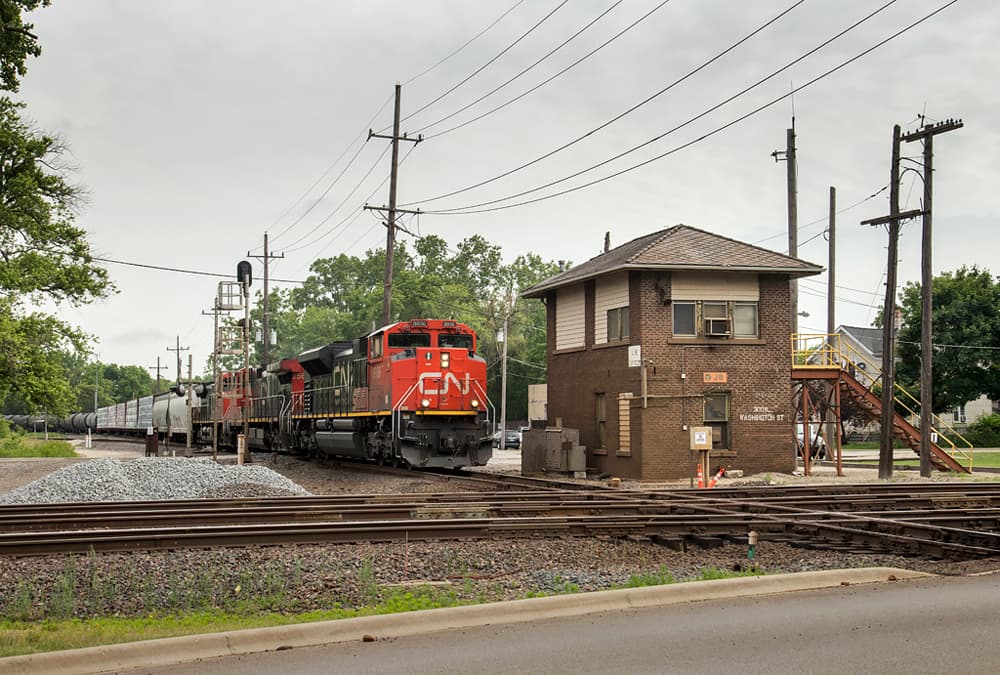Canadian National EMD SD70M-2 No. 8836 leads a merchandise freight, with five loaded center beams on the head end, passes the still-manned Elgin, Joliet & Eastern JB Tower in West Chicago, Ill., crossing the UP’s ex-Chicago and North Western mainline. CN and UP are America’s biggest transporters of lumber by rail. Chase Gunnoe.
WASHINGTON — Thirty-year-high mortgage rates and a double-digit decrease in U.S. housing starts from a year ago has only curbed Class I railroads’ lumber business by about 3,300 carloads, down just 1%, compared to July 2023. Now proposed Federal interest rate cuts could rejuvenate residential housing starts and give railroads’ lumber business a jolt.
U.S. Class I railroads, including the U.S. rail traffic of Canadian National and Canadian Pacific Kansas City, have moved more than 244,000 carloads of lumber so far this year, managing to keep the business mostly flat in the past year despite soaring mortgage rates that peaked at 7.7% for a 30-year fixed mortgage in October 2023.
Mortgage rates remain high today at 6.8% on average, mostly on par with last summer and well above historical norms, according to data from mortgage company Freddie Mac. At the same time, U.S. housing starts have continued to fall, decreasing 5% from April to May 2024 to an annualized rate of 1.28 million homes, the lowest since July 2020, and down 18% from a year ago, according to U.S. Census Bureau data.
With inflation cooling and the Fed expected to decrease interest rates at least once in 2024, this could eventually entice home builders and prospect buyers to re-enter the market, increasing demand for lumber, and giving railroads the opportunity to capture new demand. Housing starts are now on-par with pre-pandemic July 2019’s 1.24 million homes, after the pandemic uprooted the industry, causing new residential construction to spiral to 931,000 homes in April 2020 before rallying to a peak of 1.83 million homes two years later in April 2022.
As borrowing costs increased, the housing market cooled and lumber prices dropped. High interest rates are impacting home buyers’ affordability and the cost to build new homes is more expensive than two years ago. This is keeping housing inventory low and buying subdued, further contributing to a U.S. housing shortage estimated at more than three million homes, caused in part by decades long periods of too few new homes being built.
As for how railroads are managing this quandary, volume isn’t down as much as some would think. In the U.S., Canadian National moves the most lumber of any Class I railroad, having hauled 66,277 carloads so far this year. Its business is down 2.7% year over year, a decrease of about 1,845 carloads. In comparison, Union Pacific, the second-largest hauler of lumber by volume, has tallied 55,341 carloads, down 4%, or about 2,000 fewer carloads.
Both BNSF Railway and Canadian Pacific Kansas City’s lumber business is flat, down less than 1% compared to a year ago. In the East, CSX Transportation’s lumber business is down 1%. In contrast to other carriers, Norfolk Southern’s lumber business is up 1,275 carloads, or 5% ahead of last year. The carload data is compiled and published by each Class I railroad as part of its weekly reporting to the Association of American Railroads.
But falling interest rates isn’t a sure bet that railroads will start hauling more center-beams. Trucking is the perpetual thorn in the side for railroads and decreased consumer discretionary spending, also a byproduct of high interest rates, has truckers ready to work. Railroads will have to get creative to capture business in short-haul markets supplied by southern yellow pine in the Southeast or spruce pine and other fibers originating from the Pacific Northwest where trucks can be more flexible and cost effective.
The pandemic-induced days of $1,500-per-thousand-board-foot for lumber have ended and railroads will have to be increasingly cognizant of lumber producers’ focus on cost and transportation spend as the market rebalances. Lumber futures are currently trading at $435-per-thousand-board-foot, more on par with pre-pandemic pricing.
In preparation for the highly anticipated, but gradual expectation of loosened monetary policy, now is the time where railroads are — or should be — developing strategies to bolster this business unit before front yards start filling up with for sale signs.
